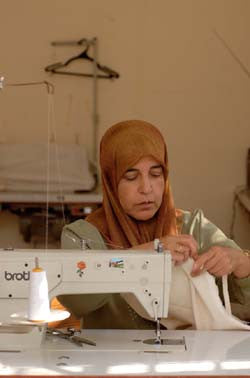Surif Women's Cooperative
 Location: Surif village, West Bank
Location: Surif village, West Bank
Beneficiaries: 200 women from Surif village

The village of Surif (pop. 15,000) is located alongside the Green Line (1949 Armistice Line separating the West Bank and Israel), in a beautiful hilly region between Bethlehem and Hebron. About a half of the village population are refugees from the 1948 war, who fled their homeland which later became a part of the State of Israel.
The Surif Women’s Cooperative was founded in 1950 by Mennonite volunteers. Surif’s crafts are known for their distinct style, using cream-colored cotton fabric instead of the common black fabric. The fabric they use is made in the Old City of Jerusalem, woven on an antique handloom by Adnan Fares, a weaver that carries on the centuries-old tradition.
The embroidery patterns are produced by a system of counting threads, a method that gives the embroidery its striking and exact appearance on both sides of the fabric. Surif’s designs are adapted from traditional Palestinian dresses and reflect the heritage from different regions of Palestine.
View our product range from the Surif Women's Cooperative here >>
These products are certified Fair Trade: creating opportunities for disadvantaged producers, sustaining fair working conditions and wages, empowering women, and preserving traditional crafts and artisan skills.

Cross-stitch embroidery in Palestine
Once a traditional craft practiced by village women, Palestinian cross-stitch embroidery has become an important symbol of Palestinian culture. Embroidered pieces can be found in the homes of most Palestinian families in the West Bank, Gaza Strip, Israel and the Diaspora beyond, adorning the walls of houses in Jerusalem, villas in the Gulf, suburban homes in the United States, and cement block houses in refugee camps. In addition, cross-stitch embroidery is given as gifts and worn by Palestinians worldwide on festive occasions.
The popularity of embroidery springs from both its beauty and its association with the Palestine of the past. Common patterns reflect the millennia-long history of the land. The designs are derived from sources as diverse as ancient mythology and foreign occupations and date as far back as the Canaanites, who lived in the area over three thousand years ago.
The handicraft also symbolises the traditional rural lifestyle of Palestine, much of which was lost after the 1948 creation of the state of Israel. Embroidery was the principal decoration of rural women's clothing. It was part of a village women's daily routine and a means of showing off her personal skills and social identity. The patterns, colours and quality of the dress reflected a woman's social standing, marital status and wealth.
Although the Palestinian cultural landscape has changed dramatically in the last fifty years, cross-stitch embroidery has remained a vibrant handicraft because, for many Palestinians, it is a familiar reminder of Palestine in the days of their grandparents or great-grandparents.
